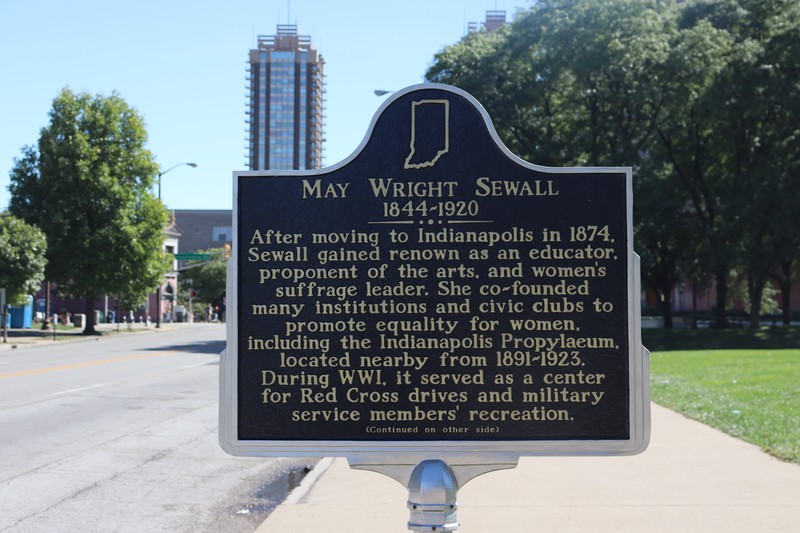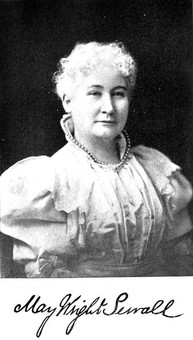May Wright Sewall Historical Marker
Introduction
Text-to-speech Audio
This historical marker commemorates one of Indiana's leading educators and women's rights advocates of the 19th and early 20th centuries, May Wright Sewall (1844-1920). Her achievements include helping establish over 50 women's rights and education organizations, such as the International Council of Women, the Indianapolis Equal Suffrage Society, and the Indianapolis Women's Club. She co-organized the 40th anniversary convention of the 1848 Seneca Falls Convention, the country's first women's rights convention. She was also a delegate to the Universal Congress of Women in Paris, France, became president of the National Federation of Women's Clubs in 1889, and helped establish the National Council of Women of the United States. In her final years she became an advocate of world peace. She died just one month before the 19th Amendment, which guaranteed women's right to vote, was ratified in 1920.
Images
The historical marker is located on North Street on the northern side of Obelisk Square

May Wright Sewall (1844-1920)

Backstory and Context
Text-to-speech Audio
May Wright Sewall was born in Greenfield, Wisconsin (a suburb of Milwaukee) on May 27, 1844. She became an avid reader at a young age and was apparently reading the works of British poet John Milton when she was seven. As a young woman, she became a teacher and taught in another Milwaukee suburb, Waukesha, and then enrolled in Northwestern Female College, which eventually merged with Northwestern University. In 1866, she earned a degree in science. In doing so, she became one of the first women outside of Oberlin College to earn a degree. Sewall later earned a master's degree in art in 1871, also from Northwestern Female College. Before that she taught in Mississippi, Michigan, and in Franklin, Indiana, where she met her first husband, Edwin, whom she married in 1872. They moved to Indianapolis in 1874. Sadly, he died of tuberculosis the next year.
Sewall married Theodore Sewall, who was a principal in Indianapolis, in 1880. In 1882, they established the Classical School for Girls, which became well respected (Theodore founded the Classical School for Boys in 1874). Sewall served as principal for 25 years and taught literature. She and Theodore were both progressives and they acquainted themselves with similar-minded intellectuals, whom they often invited to their house. They did not have children.
Sewall began to make a name for herself nationally in 1878 at the women's rights convention in Rochester, New York, where she met suffragist leaders Elizabeth Cady Stanton and Susan B. Anthony in 1878. That year she also helped establish the Indianapolis Equal Suffrage Society. Between 1881 to 1883, Sewall oversaw a state-wide women's suffrage campaign that was almost successful. In 1882, she became chairman of the National Woman Suffrage Association (NWSA) and remained in that position until 1890.
At a meeting of national and international women's organizations the NWSA held in 1888 (the 40th anniversary celebration of the Seneca Falls Convention was part of this gathering), in a speech Sewall was the first to suggest that a permanent "council" of international women's organizations be established. The delegates voted in favor of the idea, thus establishing the International Council of Women (ICW), which still exists today. Between 1891-1895 and 1897-1899, Sewall served as president National Council of American Women of the United States. She then served as president of the ICW from 1899-1904. At the 1893 World's Columbian Exposition, Sewall organized a gathering of national and international feminists. The next year, President William McKinley appointed her as a Special Representative to the Congress of Women to the World's Fair in Paris.
Sewall's peace activism started in 1895. Between 1904-1914, she chaired the ICW's committee on peace and international arbitration. She gave speeches, wrote about international cooperation, and in 1915, organized a women's conference at the Panama-Pacific Exposition in San Francisco. That year she also sailed to Europe on a peace mission with Henry Ford and others on the so-called "Peace Ship."
After living in New England since 1907, she returned to Indianapolis in 1919 due to declining health. She died on July 22, 1920.
Sources
"May Eliza Wright Sewall." Britannica. Accessed July 4, 2023. https://www.britannica.com/biography/May-Eliza-Wright-Sewall.
"May Wright Sewall." Encyclopedia Indianapolis. Last Updated March 2021. https://indyencyclopedia.org/may-wright-sewall.
"May Wright Sewall." The Historical Marker Database. Accessed July 4, 2023. https://www.hmdb.org/m.asp?m=200290.
Stephens, Jane. "May Wright Sewall: An Indiana Reformer." Indiana Magazine of History. pp. 273-278. https://scholarworks.iu.edu/journals/index.php/imh/article/view/10416/14544.
The Historical Marker Database
